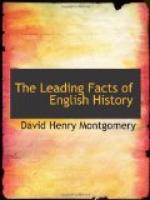V. General Industry and Commerce
524. Manufactures.
Woolen goods continued to be a chief article of manufacture. Silks were also produced by thousands of Huguenot weavers, who fled from France to England in order to escape the persecutions of Louis XIV. Coal was now extensively mined, and iron and pottery works were giving industrial importance to Birmingham and other growing towns in the Midlands.
525. Commerce.
A permanent English colony was established in America in 1607, and by 1714 the number of such colonies had increased to twelve. During a great part of this period intense commercial rivalry existed between England and Holland, each of which was anxious to get the monopoly of the colonial import and export trade. Parliament passed stringent navigation laws, under Cromwell and later, to prevent the Dutch from competing with English merchants and shippers. The East India and South Sea companies were means of greatly extending English commercial enterprise, as was also the tobacco culture of Virginia.
526. Roads and Travel.
Good roads were still unknown in England. Stagecoaches carried a few passengers at exorbitant rates, requiring an entire day to go a distance which an express train now travels in less than an hour. Goods were carried on pack horses or in cumbrous wagons, and so great was the expense of transportation that farmers often let their produce rot on the ground rather than attempt to get in to the nearest market town.
In London a few coaches were in use, but covered chairs, carried on poles by two men and called “sedan chairs,” were the favorite vehicles. They continued to be used for a century after this period closes. Although London had been in great part rebuilt since the Great Fire (1666), the streets were still very narrow, without sidewalks, heaped with filth, and miserably lighted.
527. Agriculture; Pauperism.
Agriculture generally made no marked improvement, but gardening did, and many vegetables and fruits were introduced which had not before been cultivated.
Pauperism remained a problem which the government had not yet found a practical method of dealing with. There was little freedom of movement; the poor man’s parish was virtually his prison, and if he left it to seek work elsewhere, and required help on the way, he was certain to be sent back to the place where he was legally settled.
VI. Mode of Life, Manners, and Customs
528. Dress.
In the time of Charles II and his successors the dress of the wealthy and fashionable classes was most elaborate and costly. Gentlemen wore their hair long, in ringlets, with an abundance of gold lace and ruffles, and carried long, slender swords, known as rapiers. Sometimes indeed they outshone the ladies in the splendor of their costume, and in one instance the bride at a wedding burst into tears because her gorgeously dressed husband looked so much handsomer than she did that all eyes were fixed on him alone. Later on, large flowing wigs came into fashion, and no man of any social standing thought of appearing without one.




